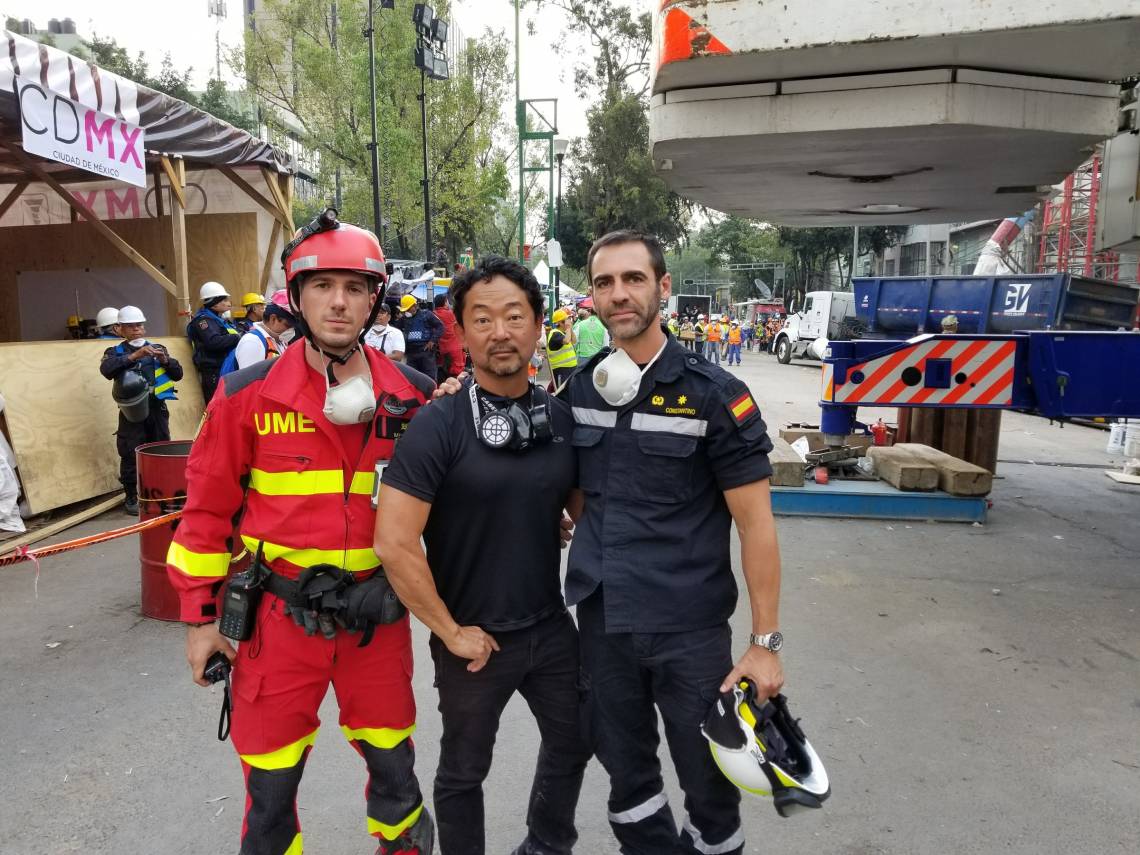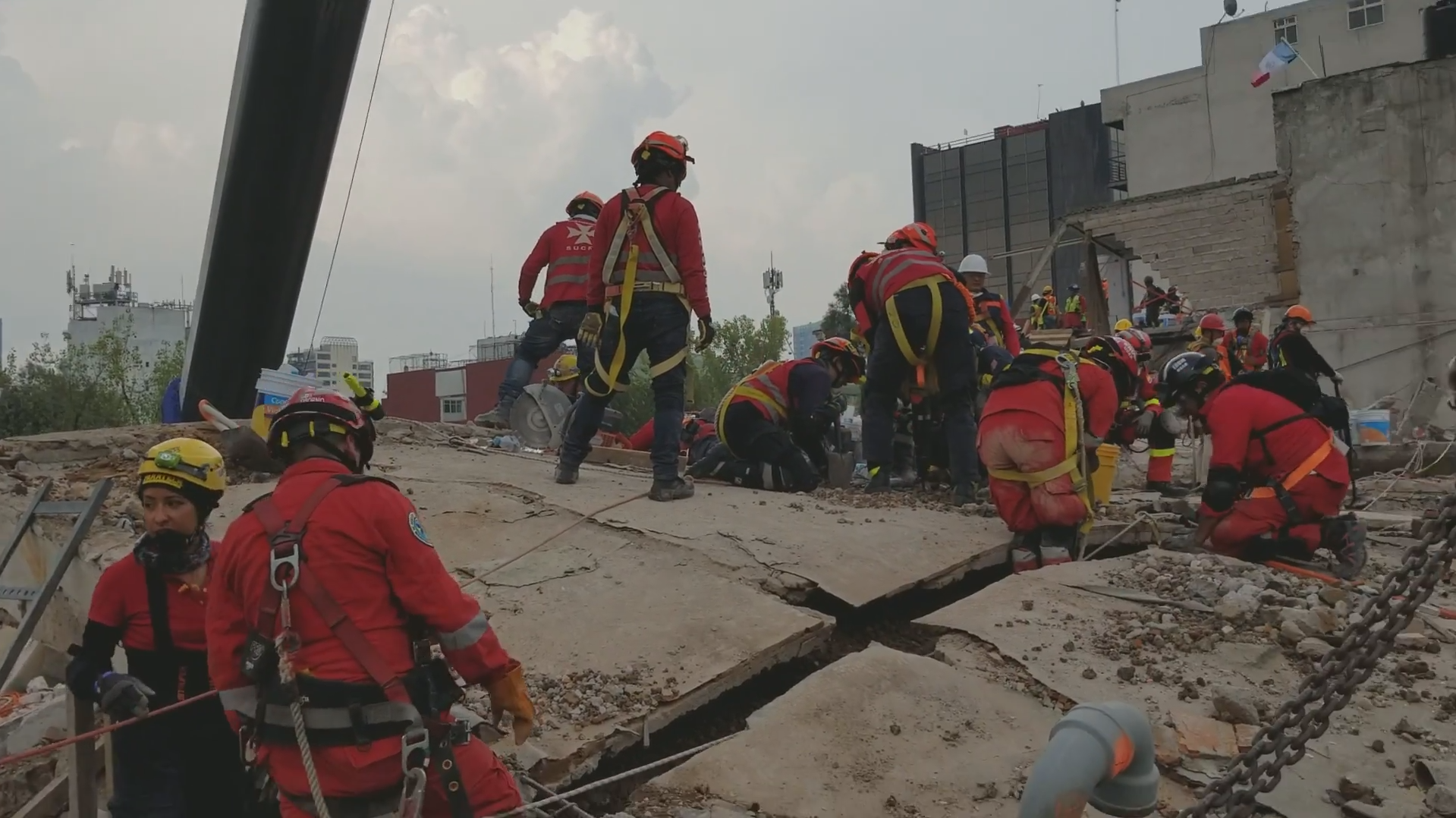Mexico City Earthquake
Under A Collapsed Building
I’m in Mexico City a week after the earthquake and this is our first day assisting a local engineering team. A seven-story concrete office building has collapsed. They call it Site 286. More than 40 people died here, probably the largest number of fatalities in a single structure.
“Let me radio in for them to stop
throwing concrete debris in our pathway.”
“Alto! (Halt!),” a Spanish urban search-and-rescue (USAR) officer yells at me. “Let me radio in for them to stop throwing concrete debris in our pathway.”
They’ve asked for assistance evaluating whether concrete debris piled up against the collapsed building is causing additional instability. Picture this: The top six levels are pancaked on top of the building’s bottom level. It is now heavily shored at the ground floor. More than 100 extensively equipped USAR members drill and cut from above to peel off concrete slabs a chunk at a time. They are from all over the world: Mexico, Israel, Germany, Spain, Korea. High-tech laser survey equipment measures even 1 mm of movement. A large overhead crane roams overhead. It is a highly technical operation.

All this is accomplished pretty much by professional volunteers who rushed to the site. Unbelievable. Government-led Mexican civil protection, firefighters, city and Marine troops provide efficient organizational structure and security. Twenty people remain missing here. We need to secure everyone. Quickly.
We climb to the top of the collapsed structure through the building next door, then walk over the busy collapsed site to the building on the other side. As we descend stairs, we carefully examine each floor. We inspect the cracks to understand what’s going on. On the fourth floor, I see a wall with horizontal, gridline-like cracks slightly bulged inward. I instantly recognize the wall is about to burst inward toward us because of the huge amount of debris pressure against it. This is the same crack pattern I saw in the 2011 Tohoku Japan Tsunami. The great pressure of the tsunami wave caused this same pattern of damage to concrete walls. As I explain this, an engineer radios upstairs to start removing the pressure by removing debris.

The lead engineer, mid-40s, is normally a civil engineer employed as technical director of a construction company, but when this crisis arose, he stepped in. All his life experience prepared him for this challenge. It is almost like someone above positioned him at the right place, at the right time. He mobilizes an army of volunteering specialists and equipment. He foregoes his paying job to serve his people. He is a hero; the most capable one. He and his team work around-the-clock here to make sure the USAR team is safe while they retrieve bodies.
His eyes are filled with sorrow, but also at peace. You may ask why we take such risks to do this. For the family members waiting outside, there is always hope. That’s why we do it.
A Spanish USAR officer comes up with quick shoring schemes for the walls. We walk downstairs, over debris, then scale a fragile ridge of more debris to the other side of the collapsed building to inspect the condition of exposed steel stairs that could threaten a survey crew nearby. The bottom steel is bent and a major aftershock could dislodge it. We move the survey crew to a safer location.
The Spanish USAR officer is a 30-something Army officer, firefighter and engineer. He and his team’s mission is to retrieve a Spanish citizen’s body, as well as to work with others. “One hour ago,” he says, “we finally discovered his body. I met his wife. She gave me earrings that her now-deceased husband gave to her for their final anniversary. She asked me to give these to my wife.” All of us cried.
Day 1: Death, sadness and mariachi music
I crawl through a bunch of cracked concrete, twisted reinforcing bars and pancaked furniture. Overhead, the concrete deck is getting narrower and narrower as I progress the gap in this collapsed concrete building. The floor above is skewed 45 degrees, with outside light streaming through. The floor essentially collapsed onto this floor. The smell of death is everywhere.
Our team arrived here in Mexico City at 3 am last night (Tuesday) from Costa Rica. We have been scanning through the damaged Condesa neighborhood this morning. It is a nice neighborhood of little cafes and parks. We notice that damages are spotty and not as heavy as I have seen in the past in the 2008 Sichuan or 2011 New Zealand earthquakes. This earthquake was M 7.1, but it was not shallow at 51 km deep with the epicenter 150 km away. This reduced the earthquake energy before it reached this city. Around noon, we entered a cordoned area of a collapsed building. It was a five-story concrete office building now reduced to two stories. The top four levels are pancaked on the second floor. Massive chunks of concrete floor are resting on one level of the structure, which is now supported by an impressive amount of steel shoring. Firefighters, rescue workers and Mexican marines are everywhere. A chief engineer on site requested to meet us.
“We lost 20 people here
and we think 20 bodies are still buried here”
“We lost 20 people here and we think 20 bodies are still buried here,” he explained to us. “We are doing the best we can to get to the bodies, but I want to go through our technical process with you.” He wants to make sure that structural stability exists while his USAR team is in the building amid aftershocks. They are a truly professional bunch; many are volunteers, including the chief engineer. Another engineer tells me: “I actually live three blocks from here and I arrived a day after to this site and have been working here 24/7 since. This is my community, so it’s my duty to help my people.”

We go into the structure to hear how the USAR team intends to make holes to reach the bodies. A Spanish USAR officer yells at me. “Very careful! There is body fluid dripping from the crack above here.” The smell is a combination of dust, concrete and death. It is a smell that will never leave you. Our trusted Mexican chief engineer leads the way to the location he is looking for. Three of us discuss the sequence of the operation. A USAR leader wants to punch a hole from below to get to the bodies faster, but the chief engineer wants to go from the top, which is much safer. They used sensors and search dogs throughout to locate people. No signs of life, very sadly. After six days, they know there is no one living left under this pile.
In the very end, we all agreed on the safer top-down approach. It is a prudent approach to avoid unnecessary risk to USAR lives. We come across more bodies close to collapsed staircases. Many people from this building ran out down these staircases and saved their lives. Some didn’t make it.
“I met a friend who worked here, and he told me he ran to a staircase with two other colleagues when the shaking began,” an engineer tells me. “Two of them turned around to help a lady who fell. But my friend kept running and, last minute, he jumped to the staircase as the building around him was collapsing with tremendous noise and dust.”
We talked about the danger of this type of building, which is pre-1985 nonductile concrete. Mexico City experienced an even more powerful earthquake in 1985 and building regulations changed substantially after that. Old concrete structures are one of the most dangerous building types that exist on earth. Their inadequate reinforcing details make the concrete very brittle under seismic motion. All damaged buildings we saw today were this type. You know how we teach people to duck under a desk during an earthquake? We teach this in California. But if I’m in a nonductile concrete structure, I will run as fast as I can outside and so should everybody.
This earthquake was also different from the 1985 one. The Mexico City earthquake in 1985 was a long-distance earthquake with long, swaying motion. This affected taller structures, six stories and higher. But this earthquake had a much sharper and faster shaking motion, which impacted three- to six-story structures more. It’s what we called “resonance effect.” Every earthquake is different and affects different types of buildings. So, one cannot say that a building is safe if it went through one earthquake. Next one can be totally different. That’s why seismic strengthening is important. It saves lives and it is feasible and cost-effective.
It is getting darker and we say goodbye to our brave rescue workers. Rain is starting to beat on our hardhats. It’s getting cold and wet and I suddenly realize the team has not eaten all day. We find a little hole-in-wall joint and run into it. It’s packed and a mariachi band is playing loud. There’s tequila and beer on every table, it seems. Everyone in the restaurant looks over at us as we enter. They notice our hardhats, headlamps and breathers. Suddenly, people stand up and applaud. This is a total surprise. I’ve had plenty of people thank us for what we do in the past, but I’ve never been in a standing ovation. A big guy with a cowboy hat at the corner table orders three beers for each for us. Our sad memories of the building fade a bit with the cheerfulness and friendly smiles from the Mexican people and the lively Mariachi music.
It is getting darker and we say goodbye to our brave rescue workers. Rain is starting to beat on our hardhats. It’s getting cold and wet and I suddenly realize the team has not eaten all day. We find a little hole-in-wall joint and run into it. It’s packed and a mariachi band is playing loud. There’s tequila and beer on every table, it seems. Everyone in the restaurant looks over at us as we enter. They notice our hardhats, headlamps and breathers. Suddenly, people stand up and applaud. This is a total surprise. I’ve had plenty of people thank us for what we do in the past, but I’ve never been in a standing ovation. A big guy with a cowboy hat at the corner table orders three beers for each for us. Our sad memories of the building fade a bit with the cheerfulness and friendly smiles from the Mexican people and the lively Mariachi music.
